CONTROL OF MACHINES
WITH FRICTION
�
THE KLUWER INTERNATIONAL SERIES
IN ENGINEERING AND COMPUTER SCIENCE
ROBOTICS: VISION, MANIPULATION AND SENSORS
Consulting Editor: Takeo Kanade
ROBOTIC GRASPING AND FINE MANlPULATION, M. Cutkosky
ISBN: 0-89838-200-9
SHADOWS ANDSlI..HOUETrES IN COMPUTER VISION, S. Shafer
ISBN: 0-89838-167·3
PERCEPTUAL ORGANlZATION AND VISUAL RECOGNITION, D. Lowe
ISBN: 0-89838-172·X
ROBOT DYNAMICS ALGORITHMS, F. Featherstone
ISBN:
0-89838-230-0
THREE- DIMENSIONAL MACHINE VISION, T. Kanade (editor)
ISBN: 0-89838-188-6
KINEMATIC MODEUNG, lDENTIFICATION AND CONTROL OF
ROBOT MANlPULATORS, H.W. Stone
ISBN:
0-89838-237-8
OBJECT RECOGNITION USING VISION AND TOUCH, P. Allen
ISBN: 0-89838-245-9
INTEGRATION, COORDINATION AND CONTROL OF MULTI-SENSOR ROBOT SYSTEMS,
H.F. Durrant-Whyte
ISBN:
0-89838-247-5
MOTION UNDERSTANDING: Robot and Human Vision, W.N. Martin
and J. K. AggrawaI (edilors)
ISBN:
0-89838·258-0
BAYESlAN MODEUNG OF UNCERTAINTY IN LOW-LEVEL VISION,
R. Szeliski
ISBN
0-7923-9039·3
VISION AND NAVIGATION: THE CMU NAVLAB, C. Thorpe (editor)
ISBN
0·7923-9068-7
TASK-DIRECTED SENSOR FUSION AND PLANNING: A Computational
Approach, G. D. Hager
ISBN:
0-7923-9108-X
COMPUTER ANALYSIS OF VISUAL TEXTURES, F. Tomita and S. Tsuji
ISBN:
0-7923-9114-4
DATA FUSION FOR SENSORY INFORMATION PROCESSING
SYSTEMS, J. Clark and A. Yuille
ISBN:
0-7923-9120-9
PARALLEL ARCHITECTURES AND PARALLEL ALGORITHMS FOR INTEGRATED VISION
SYSTEMS, A.N. Choudhary, J. H. Patel
ISBN:
0-7923·9078-4
ROBOT MOTION PLANNING, J. C. LaTombe
ISBN:
0-7923·9129-2
�
CONTROL OF MACHINES
WITH FRICTION
by
Brian Armstrong-Helouvry
University of Wisconsin, Milwaukee
SPRINGER-SCIENCE+BUSINESS MEDIA, LLC
~. "
�
Llbrary of Congress Cataioging-In-PubUeation Data
Armstrong-Helouvry, Brian, 19S8-
Control of machines with friction / Brian Armstrong-Helouvry.
(The Kluwer international series in engineering and
p. cm. -
computer science. Robotlcs)
ISBN 978-1-4615-3972-8 (eBook)
II. Series.
90-20760
CIP
Includes bibliographical references and index.
ISBN 978-1-4613-6774-1
DOI 10.1007/978-1-4615-3972-8
1. Tribology. 2. Machinery-Design.
I. Title.
TJl07S.A67 1991
621.8 '9-dc20
Copyright © 1991 Springer Science+Business Media New York
Originally published by Kluwer Academic Publishers in 1991
Softcover reprint ofthe hardcover Ist edition 1991
Ali rights reserved. No part of this publication may be reproduced, stored in a retrieval
system or transmitted in any form or by any means. mechanical, photo-copying, recording,
or otherwise, without the prior written permission of the publisher, Springer-Science
Business Media, LLC.
Printed on acid-free paper.
�
CONTROL OF MACHINES
WITH FRICTION
�
Contents
Preface
1.
2.
Introduction
Friction in Machines
2.1. The Contemporary Model of Machine Friction
2.2. Boundary Lubricants: a Domain of Many Choices
2.3. Relaxation Oscillations
2.4. Friction Modeling in the Controls Literature
2.5. An Integrated Friction Model
.
.
3.
Experiment Design
4.
5.
Repeatability
Break-Away Experiments
5.1. Experimental Issues in Measuring Break-Away Torque
5.2. Building the Compensation Table
6.
Friction as a Function of Velocity
6.1. Analysis of Variance in the Motion Friction Data
6.2. Friction at Low Velocities
6.3. Friction During Compliant Motion
6.4. The Dahl Effect
6.5. The Stribeck Effect
6.6. Temporal Effects in the Rise and Decay of Friction
6.7. Variance in Friction as Process Noise
. . . . .
vii
zx
1
7
11
21
24
35
41
43
47
55
55
58
63
64
66
68
78
80
88
91
�
viii
Control of Machines with Friction
7.
Analysis of Stick-Slip
7.1. Dimensional Analysis
7.2. Perturbation Analysis
7.3. The Impact of Static Friction Rising
as a Function of Dwell Time
Integral Control
. . . . .
7.4.
8. Demonstrations of Friction Compensation
8.1. Open-Loop Motion of One Joint
8.2. Open-Loop Motion of Three Joints
8.3. Friction Compensated Force Control
95
98
101
108
116
125
125
129
134
9.
Suggestions Toward Friction Modeling and Compensation 141
9.1. Suggestions on Experimental Technique
9.2. Suggestions on Control
. . . .
9.3. Conclusion
Bibliography
Appendix A: Small Studies
Friction as a Function of Motor Angle
Joint 2 Motor Alone and Joint 2 Link Alone
Trials with Dither
Friction as a Function of Load
Creep
Effects that were not Observed
. . . . .
.
A.1
A.2
A.3
A.4
A.5
A.6
Index
142
143
144
147
157
157
159
162
164
166
167
169
�
Preface
It is my ambition in writing this book to bring tribology to the study
of control of machines with friction. Tribology, from the greek for study
is the discipline that concerns itself with friction, wear and
of rubbing,
lubrication. Tribology spans a great range of disciplines, from surface physics
to lubrication chemistry and engineering, and comprises investigators in
diverse specialities. The English language tribology literature now grows at
a rate of some 700 articles per year. But for all of this activity, in the three
years that I have been concerned with the control of machines with friction,
I have but once met a fellow controls engineer who was aware that the field
existed, this including many who were concerned with friction. In this vein I
must confess that, before undertaking these investigations, I too was unaware
that an active discipline of friction existed. The experience stands out as a
mark of the specialization of our time.
the central
is more often concerned with wear, with respect
Within tribology, experimental and theoretical understanding of friction
in lubricated machines is well developed. The controls engineer's interest
interest of the tribologist. The
is in dynamics, which is not
tribologist
to which
there has been enormous progress - witness the many mechanisms which
we buy today that are lubricated once only, and that at
the factory.
Though a secondary interest,
frictional dynamics are note forgotten by
In this monograph something over one hundred references to
tribology.
the tribology literature are considered and their implications for control
addressed.
in the early years
investigation, when the dynamics could be used as a tool
of tribological
to explore basic interface phenomena.
Since the 1960's there has been
in part because more powerful means have been
less interest in dynamics,
developed to explore interface physics, and in part because, at least within
some quarters of tribology,
the dynamics of friction in lubricated machines
was considered to be a solved problem. No problem is ever completely solved
and, as a half score of recent references attest, interest in dynamics is rising
again. This time with predictive models of mechanism friction; models based
on three decades of progress in surface and lubricant physics.
Interest
in frictional dynamics was greatest
ix
�
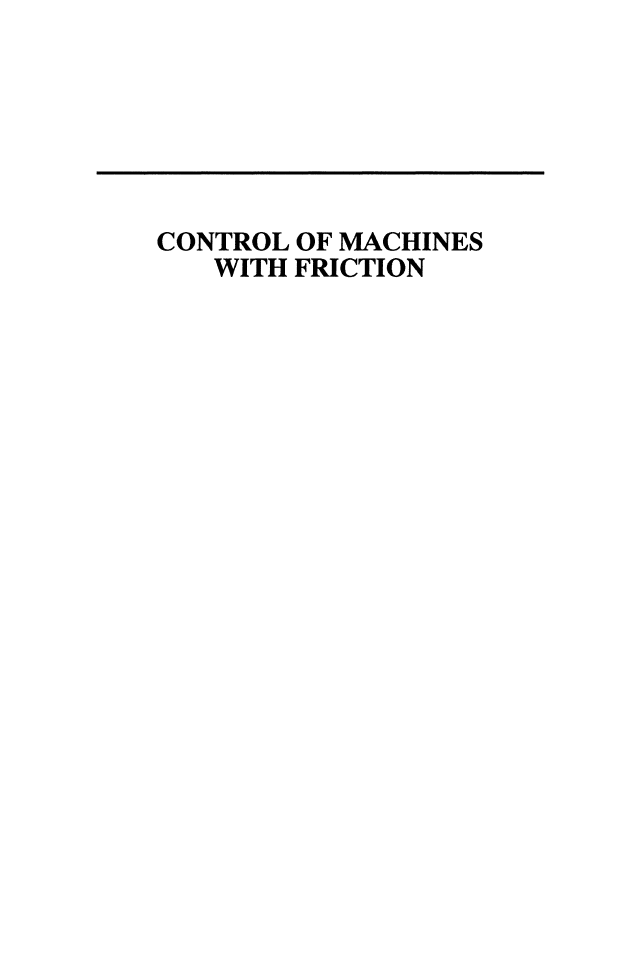
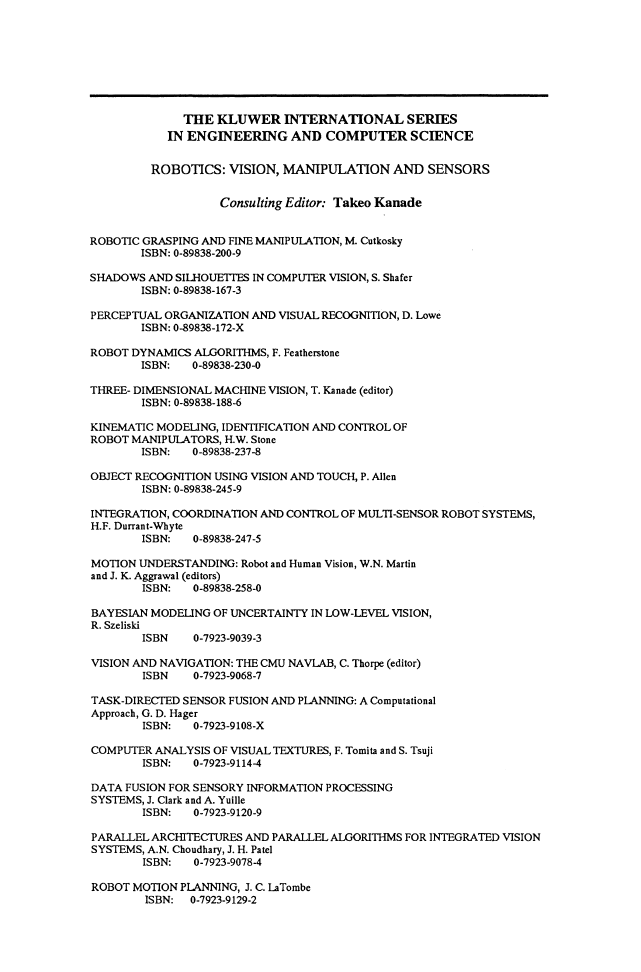
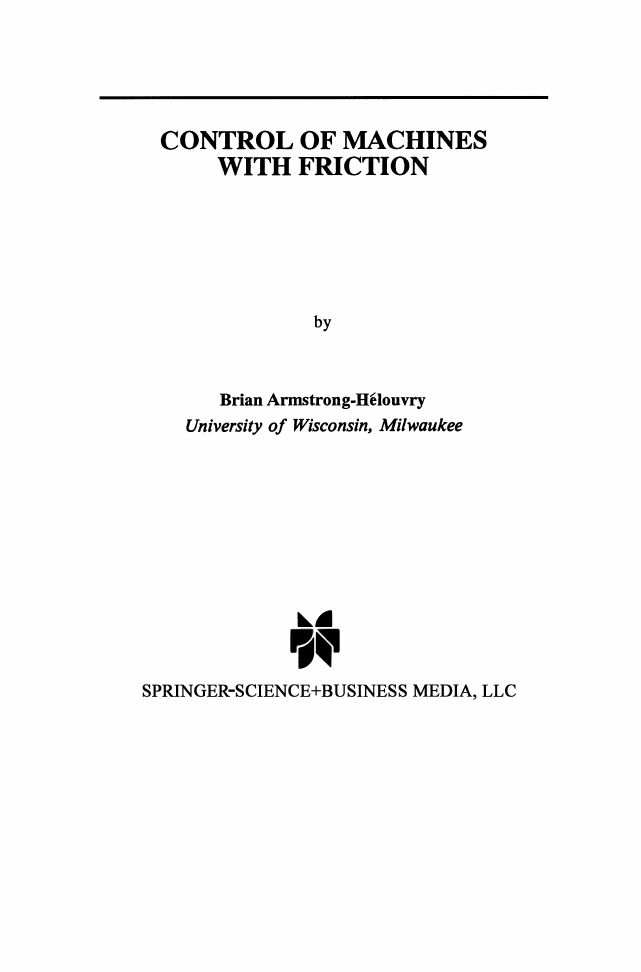

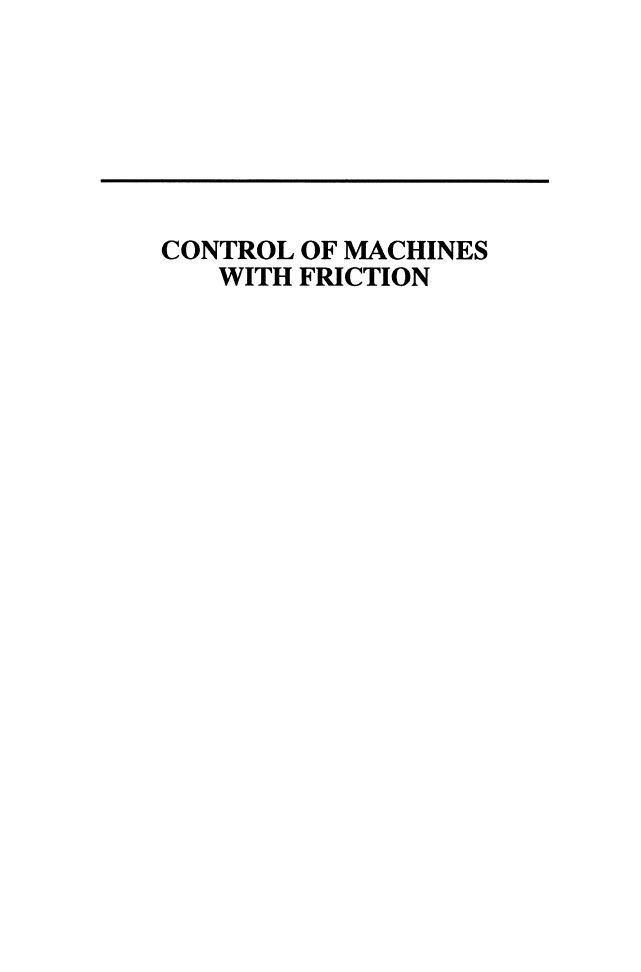
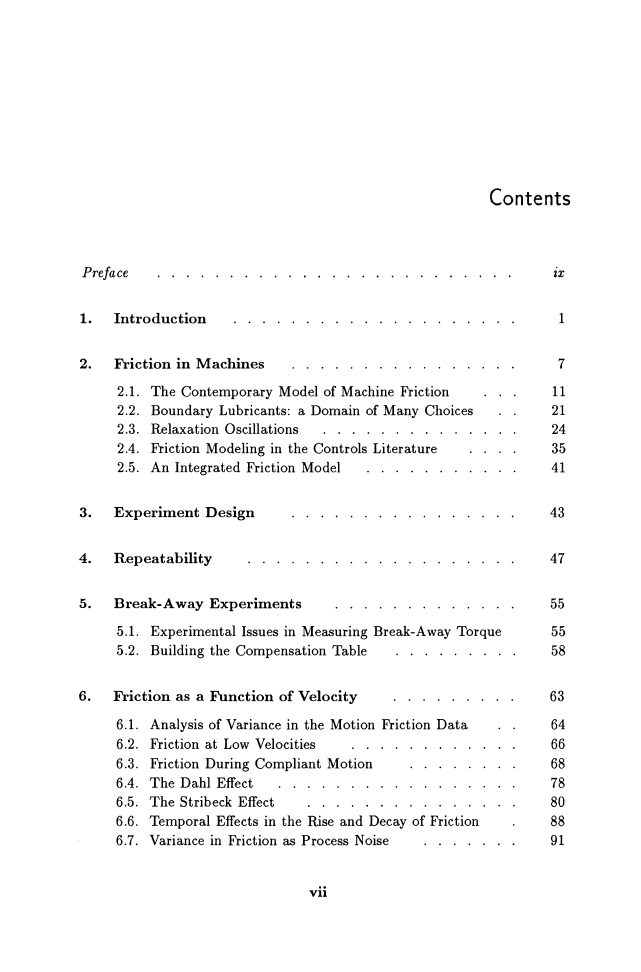
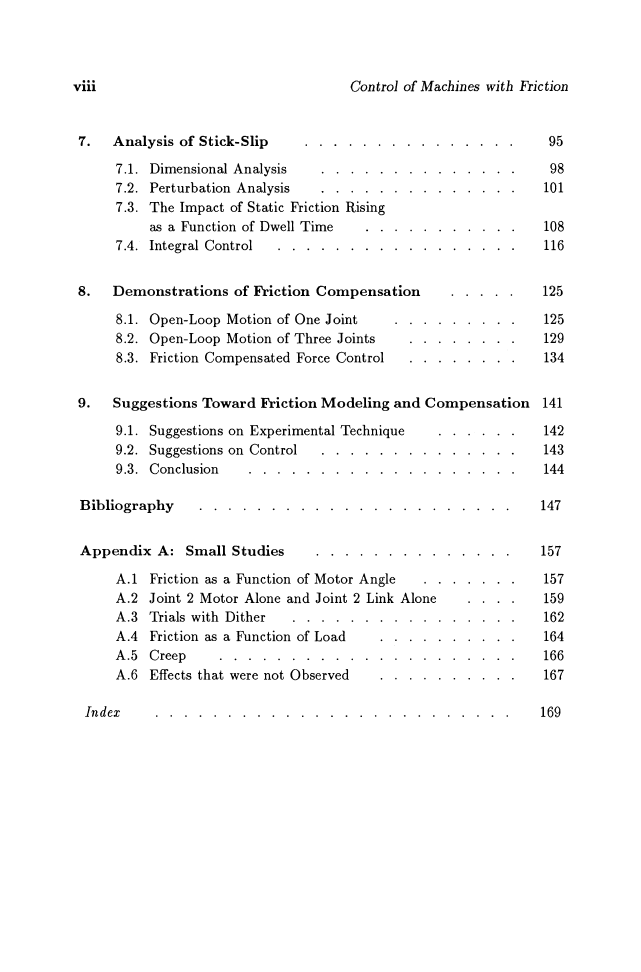
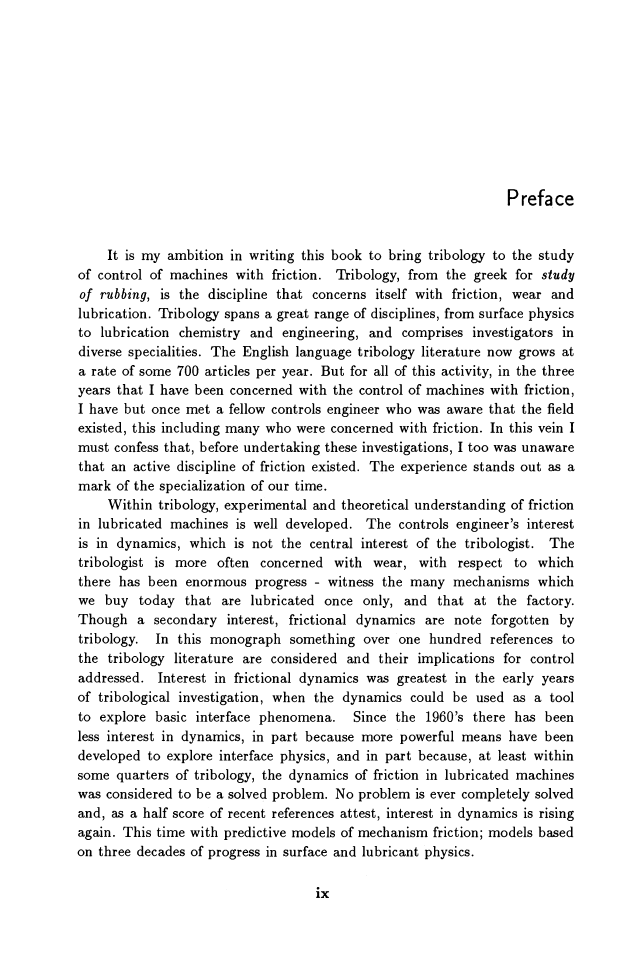








 2023年江西萍乡中考道德与法治真题及答案.doc
2023年江西萍乡中考道德与法治真题及答案.doc 2012年重庆南川中考生物真题及答案.doc
2012年重庆南川中考生物真题及答案.doc 2013年江西师范大学地理学综合及文艺理论基础考研真题.doc
2013年江西师范大学地理学综合及文艺理论基础考研真题.doc 2020年四川甘孜小升初语文真题及答案I卷.doc
2020年四川甘孜小升初语文真题及答案I卷.doc 2020年注册岩土工程师专业基础考试真题及答案.doc
2020年注册岩土工程师专业基础考试真题及答案.doc 2023-2024学年福建省厦门市九年级上学期数学月考试题及答案.doc
2023-2024学年福建省厦门市九年级上学期数学月考试题及答案.doc 2021-2022学年辽宁省沈阳市大东区九年级上学期语文期末试题及答案.doc
2021-2022学年辽宁省沈阳市大东区九年级上学期语文期末试题及答案.doc 2022-2023学年北京东城区初三第一学期物理期末试卷及答案.doc
2022-2023学年北京东城区初三第一学期物理期末试卷及答案.doc 2018上半年江西教师资格初中地理学科知识与教学能力真题及答案.doc
2018上半年江西教师资格初中地理学科知识与教学能力真题及答案.doc 2012年河北国家公务员申论考试真题及答案-省级.doc
2012年河北国家公务员申论考试真题及答案-省级.doc 2020-2021学年江苏省扬州市江都区邵樊片九年级上学期数学第一次质量检测试题及答案.doc
2020-2021学年江苏省扬州市江都区邵樊片九年级上学期数学第一次质量检测试题及答案.doc 2022下半年黑龙江教师资格证中学综合素质真题及答案.doc
2022下半年黑龙江教师资格证中学综合素质真题及答案.doc